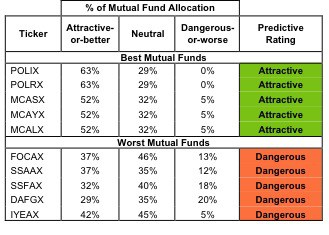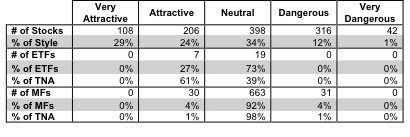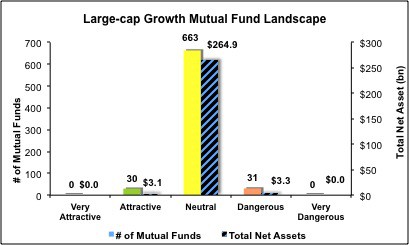The large-cap growth style ranks the best out of the twelve fund styles as detailed in my style roadmap. It gets my Neutral rating, which is based on aggregation of ratings of 26 ETFs and 724 mutual funds in the large-cap growth style as of July 16, 2012. Reports on the best & worst ETFs and mutual funds in every sector and style are here.
Figures 1 and 2 show the five best and worst-rated ETFs and mutual funds in the style. Not all large-cap growth style ETFs and mutual funds are created the same. The number of holdings varies widely (from 12 to 589), which creates drastically different investment implications and ratings. The best ETFs and mutual funds allocate more value to Attractive-or-better-rated stocks than the worst, which allocate too much value to Neutral-or-worse-rated stocks.
To identify the best and avoid the worst ETFs and mutual funds within the large-cap growth style, investors need a predictive rating based on (1) stocks ratings of the holdings and (2) the all-in expenses of each ETF and mutual fund. Investors need not rely on backward-looking ratings. My fund rating methodology is detailed here.
Investors seeking exposure to the large-cap growth style should buy one of the Attractive-or-better rated ETFs or mutual funds from Figures 1 and 2.
See ratings and reports on all ETFs and mutual funds in this style on my free mutual fund and ETF screener.
Figure 1: ETFs with the Best & Worst Ratings – Top 5
* Best ETFs exclude ETFs with less NAV’s less than 100 million.
Sources: New Constructs, LLC and company filings
Vanguard S&P 500 Growth ETF (VOOG) is excluded from Figure 1 because its total net assets (TNA) are below $100 million and do not meet our liquidity standards.
Figure 2: Mutual Funds with the Best & Worst Ratings – Top 5
* Best mutual funds exclude funds with NAV’s less than 100 million.
Sources: New Constructs, LLC and company filings
Virtus Insigh Funds Trust: Virtus Core Equity Funds (HGRIX) and (PICCX) are excluded from Figure 2 because their total net assets (TNA) are below $100 million and do not meet our liquidity standards.
Vanguard Mega Cap 300 Growth (MGK) is my top-rated large-cap growth ETF and FundVantage Trust: Polen Growth Fund (POLIX) is my top-rated large-cap growth mutual fund. Both earn my ATTRACTIVE rating.
First Trust Large Cap Growth AlphaDEX Fund (FTC) is my worst-rated large-cap growth ETF and Ivy Funds: Ivy Tax-Managed Equity Fund (IYEAX) is my worst-rated large-cap growth mutual fund. Both earn a Neutral-or-worse rating.
Per figure 3, Investors are demonstrating their ability to identify investment worthy ETFs. 61% of the capital allocated to large-cap growth ETFs is allocated to Attractive-or-better-rated ETFs. The same cannot be said for mutual funds investors since less than 1% of the capital allocated to mutual funds is allocated to investment worthy mutual funds.
The takeaway is: mutual fund managers allocate too much capital to low-quality stocks and investors are unable to identify investment worthy mutual funds.
Figure 3: Large-cap Growth Style Landscape For ETFs, Mutual Funds & Stocks
As detailed in “Cheap Funds Dupe Investors”, the fund industry offers many cheap funds but very few funds with high-quality stocks, or with what I call good portfolio management.
Investors need to tread carefully when considering large-cap growth ETFs and mutual funds. Only 7 ETFs and 30 mutual funds in the large-cap growth style allocate enough value to Attractive-or-better-rated stocks to earn an Attractive rating.
QUALCOMM Inc. (QCOM) is one of my favorite stocks held by large-cap growth ETFs and mutual funds and earns my Attractive rating. QCOM’s management has proven to be effective stewards of capital by generating a return on invested capital (ROIC) of 35% in fiscal year end 2011. This places the company in the 96th percentile of all Russell 3000 companies. In spite of strong past performance, the market is setting a low hurdle for QCOM’s future performance. To justify its current stock price (~$54.98), QCOM has to increase its after-tax profits (NOPAT) by 18.3% for only one year. This is a low hurdle given that QCOM’s average profit growth over the past 14 years has been 52%. QCOM is positioned to beat market expectations.
Hyatt Hotels Corp (H) is one of my least favorite stocks held by large-cap growth ETFs and mutual funds and earns my Dangerous rating. Hyatt is a value destroyer. The company has failed to earn an ROIC over its WACC in each of the three years I’ve covered the company, which has resulted in negative economic earnings. At fiscal year end 2011, Hyatt’s economic earnings where an astounding negative $320 million. This places Hyatt in the bottom 7th percentile of all Russell 3000 companies. To make matters worse, to justify its current stock price (~$34.54), the company must grow profits by 9.8% compounded annually for 36 years. Poor past performance coupled with a high performance hurdle make Hyatt a poor risk/reward tradeoff.
Figures 4 and 5 show the rating landscape of all large-cap growth ETFs and mutual funds.
Our style roadmap report ranks all styles and highlights those that offer the best investments.
Figure 4: Separating the Best ETFs From the Worst Funds
Figure 5: Separating the Best Mutual Funds From the Worst Funds
Review my full list of ratings and rankings along with free reports on all 26 ETFs and 724 mutual funds in the large-cap growth style.
Disclosure: I receive no compensation to write about any specific stock, sector, style or theme.





